SEO
The Only 29 Free SEO Tools You Need

Looking for a list of free, useful SEO tools? Then look no further.
You don’t need every free SEO tool under the sun. You just need enough of them to cover your use cases.
After a few years in SEO and content marketing, I’ve found these free SEO tools are all you need.
Monitor your website’s SEO health, see who’s linking to your website, and learn what your website is ranking for on Google

Before you hire an interior designer to beautify your house, the foundation of your house needs to be rock-solid. The same goes for your website. Before you go about optimizing your website, you need to make sure its technical health is strong.
Run a comprehensive crawl of your website with Ahrefs Webmaster Tools (AWT) to check for over 100 common SEO issues.
You’ll also be able to see who’s linking to your website and learn what keywords you’re currently ranking for.
Highlighted feature
This tool doesn’t just tell you what problems your site has. It’ll also tell you why a particular thing is a problem and how you can fix it.


See the top 100 keyword ideas for any seed keyword, as well as related search data


Our free keyword research tool shows you the top 100 keyword ideas for any keyword or phrase, plus the top 50 related questions. It also shows you important keyword data, such as search volume and keyword difficulty.


Highlighted feature
Besides Google, you can see keywords for other important search engines like YouTube, Bing, and Amazon. Just select the search engine you want data for:


Google’s keyword research tool


Designed for keyword research for Google Ads, Google Keyword Planner (GKP) is an invaluable tool in an SEO’s toolbox. This is mainly because the tool is from Google itself, and many SEOs believe its data is the most accurate.
But in our experiment, we found that GKP almost always overestimates “true” search volume and is only roughly accurate 45.22% of the time.
Another limitation is that GKP doesn’t show absolute search volumes—only a range (as you can see in the screenshot above). Nevertheless, it’s still a useful tool if you want to cover all your bases when it comes to keyword research.
Highlighted feature
Most keyword research tools show you ideas based on the seed keyword you entered. For example, if you search for “coffee,” you’ll get ideas like “coffee bean,” “coffee near me,” “coffee shops,” “keurig coffee maker,” etc.
GKP, on the other hand, can show you relevant keywords based on semantics. For example, you can see that GKP suggests keywords like “cappuccino,” “espresso,” “barista,” and “french press” even though they don’t contain the word “coffee.”


Recommended reading: How to Use Google Keyword Planner (Actionable Guide)
Find People Also Ask questions


For almost every query you search for on Google, you’ll see a SERP feature known as People Also Ask (PAA).


AlsoAsked scrapes them and shows you the PAA questions related to the topic you’ve entered. Use these to find subtopics and questions that may be worth answering in your article.
For example, if you are writing an article about “how to clean a coffee maker using vinegar,” you may want to answer these questions:


Highlighted feature
When you click on a PAA question in Google, more PAA questions pop up:


AlsoAsked allows you to go deeper into this research (but you’ll have to sign up for a paid plan):


Recommended reading: How to Rank in ‘People Also Ask’ Boxes and If You Should
Do keyword research on Reddit


Keyword research is about finding the topics your audience is looking for. So what better way than to find the topics people are discussing on one of the internet’s largest “forums,” aka Reddit?
Enter the name of a subreddit your audience is participating in. Keyworddit will then extract keywords from that community.
For example, here’s a list of keywords it grabbed from the r/bodyweightfitness subreddit:


Highlighted feature
Keyworddit also shows you the context where the keyword appeared:


See search trends from all around the world


Google Trends shows the popularity of a topic over time.
Use it to catch and capitalize on trending topics, as well as avoid creating content about those with waning interest.


Highlighted feature
Google Trends also shows you related topics and queries that are rising in popularity:


Cover these topics before other sites do.
Recommended reading: How to Use Google Trends for Keyword Research: 7 Effective Ways
WordPress SEO plugin for on-page and technical SEO


Imagine if you had to add your title tags, meta descriptions, OG tags, and other meta tags by yourself using code for every post you publish. You’d flip out, wouldn’t you?
But if you’re using WordPress, you don’t have to do that. RankMath helps you add all of those easily:


Besides that, RankMath also helps with:
And more.
Highlighted feature
RankMath has a comprehensive schema markup library that you can add to your posts:


See how your page will look like on the SERPs


Enter your proposed title, meta description, and URL. This tool will then show you what your webpage will potentially look like in the search results.


You can already do this if you’re using a WordPress plugin like RankMath. But it’s useful if you’re not using WordPress.
Highlighted feature
Check the Rich Snippet and Date radio buttons to see what they look like on the SERPs:


Create structured data markup in the JSON-LD format


Schema markup helps search engines better understand your content. It also powers rich snippets, which often have higher click-through rates than “regular” search results.
Merkle’s Schema Markup Generator helps you create the right schema code. Select the type of schema markup you want to generate, e.g., local business, FAQ, product, etc., fill in the form, then copy and paste the generated markup onto your site.
You can do this if you’re already using a WordPress plugin like RankMath. But if you aren’t, this is a good tool to use.
Highlighted feature
This is not a specific feature of the tool. But once you’ve generated your schema markup, you can check its validity using Schema.org’s Markup Validator.
Recommended reading: What Is Structured Data? And Why Should You Implement It?
Multi-feature browser extension that provides SEO data about the pages and websites you visit


With Ahrefs’ SEO Toolbar, you can see the valuable SEO data of any webpage you visit. These include the following:
- Page’s title
- Meta description
- Dates when page was published and modified
- Word count
- Headings
- Hreflang tags
- Canonicals
- OG tags
And more.
Besides that, the tool also:
- Checks for broken links.
- Traces redirect chains (full path).
- Highlights nofollow links.
And much more.
Highlighted feature
If you have an Ahrefs subscription, you can see our metrics within the SERPs themselves:


See the top 100 backlinks to any website or webpage


One of the most common activities in link building is to pursue your competitors’ links. By that, we mean looking at your competitors’ links and figuring out how they’ve been acquiring theirs. Then you can potentially mirror their tactics.
To do that, you’ll need to see who’s linking to them in the first place. What you can do is enter the URL of the page you’re competing with into our free backlink checker.
You’ll see the top 100 backlinks pointing to that page:


Highlighted feature
This tool also shows you the five most linked pages, most common anchor texts, the total number of backlinks and referring domains, and our proprietary Domain Rating (DR) and URL Rating (UR) scores.
These are all important information that can help you formulate your link building strategy.
Recommended reading: 7 Actionable Ways to Loot Your Competitors’ Backlinks
Find email addresses


Most link building tactics involve reaching out and persuading someone to link to your page. For that to happen, you’ll need their email address.
Hunter.io allows you to find anyone’s professional email address. Just enter the domain of the email address you’re looking for, and the tool will show you the list of email addresses it’s found:


Highlighted feature
If you’re doing link building at scale, you can use Hunter.io’s bulk email finder to find and verify email addresses in one shot.
Learn how to do this in this video:
https://www.youtube.com/watch?v=Ovu2ZYWgOJQ
Recommended reading: 6 Ways To Find Anyone’s Email Address (Tried & Tested)
Free service that connects news sources with journalists looking for expertise


Here’s how this works:
- Journalists have questions and need experts to answer them.
- HARO sends emails with those questions to their subscribers.
- Anyone can respond and potentially become a source for the journalists’ publications.
It doesn’t matter whether you’re starting out or have an established site; this is a great way to build authoritative links.
Highlighted feature
This is not a HARO feature. But signing up for HARO means you’ll begin receiving many emails from HARO a day. You’ll want to narrow down all the emails you receive from HARO to only those that are relevant to your work.
To do this, you’ll need to create a Gmail filter. Here’s how:
- Hit the caret on the right side of the search bar
- Paste [email protected] (or another feed) into the “from” field
- Add your keywords (using the OR separator) to the “Includes the words” field and use quotation marks to consider multiple words as one keyword


Recommended reading: 9 Great Public Relations Tactics With Campaign Examples
Free tool from Google that helps you monitor and troubleshoot your website’s appearance on the SERPs


Use Google Search Console to find and fix technical errors on your website, submit sitemaps, see structured data issues, check your Core Web Vitals, and more.
Highlighted feature
The URL Inspection tool provides information about Google’s indexed version of a specific page. Enter any URL and see if there are issues with it:


If you’re advanced enough, you can even use the URL Inspection API to bulk-check your data.
Recommended reading: How to Use Google Search Console to Improve SEO (Beginner’s Guide)
Free global CDN


A content delivery network (CDN) is a globally distributed server network that makes it quicker for users to access your website. It caches static content across its servers so that it can get content to load faster by serving it from a location near the visitor.
Use Cloudflare to speed up your website and protect it from malicious attacks.
Highlighted feature
Cloudflare automatically provides a free SSL certificate for your website. This is important because HTTPS protects your site and is a Google ranking factor.
Analyze the loading speed of your webpages


Page speed has been a Google ranking factor since 2010. So if your site is extremely slow, this may be a reason why it’s not ranking as well as it can be.
Use GTmetrix to check your page speed and see how the page is performing:


Highlighted feature
GTmetrix also shows you the top issues affecting your site, plus recommendations on how to improve them:


Recommended reading: How to Improve Page Speed From Start to Finish (Advanced Guide)
Optimize your images


Large images (in terms of file sizes) can take a longer time to load and, therefore, impact your page speed. Google even has extensive documentation on how to optimize your images for the web:
For best results, experiment with various quality settings for your images, and don’t be afraid to dial down the quality—the visual results are often very good and the filesize savings can be quite large.
You can use ShortPixel to compress, optimize, and resize your images.
Highlighted feature
ShortPixel automatically optimizes your media library:


Recommended reading: Image SEO: 12 Actionable Tips (For More Organic Traffic)
Create a properly formatted robots.txt file


A robots.txt file tells search engines where they can and can’t go on your site. Primarily, it lists all the content you want to lock away from search engines like Google.
If you don’t yet have a robots.txt file on your website, use this tool to quickly create one.
Highlighted feature
If you’re an advanced user, choose “Customize” to create individual rules for various bots, subdirectories, etc.:


Recommended reading: Robots.txt and SEO: Everything You Need to Know
Generate hreflang tags to specify the language and geographical targeting of a webpage


Hreflang is an HTML attribute used to specify the language and geographical targeting of a webpage.
If you have multiple versions of the same page in different languages, you can use the hreflang tag to tell search engines like Google about these variations. This helps them to serve the correct version to their users.
Use this tool to generate the correct hreflang tags for your website. Just add your desired URLs, select your target country and language, then click “Generate.”
Highlighted feature
You can bulk-upload URLs (max: 50) onto the tool. Just click “Choose file” and upload your CSV file.
Recommended reading: Hreflang: The Easy Guide for Beginners
See how the browser renders a page


This shows how the browser has rendered a page’s original HTML into the DOM, including modifications made by JavaScript.
It’s a great tool for those who need to audit or troubleshoot JavaScript issues.
Highlighted feature
View Rendered Source shows the differences between the raw version of your code and what is rendered.


Recommended reading: JavaScript SEO: What You Need to Know
See the top 10 ranking pages for any keyword


Google personalizes search results based on factors such as your location, language, and search history. As such, search results may differ widely, depending on the location you search from.
Use our free SERP checker to see real-time search results so that you can get the most accurate SERPs in the location you want to rank for.
Highlighted feature
For the first three search results, you’ll also see important SEO metrics like the number of referring domains, number of backlinks, estimated search traffic, etc.
This is helpful for assessing the top-ranking pages and understanding why these pages are ranking where they are.


See search results from any location


If you’re doing local SEO, you’ll want to see even more granular search results—right down to the city, town, or even ZIP level. You can use BrightLocal’s Local SERP Checker for that.
Highlighted feature
Depending on the country, you can even specify the language:


Google’s analytics tool


Google Analytics is quite likely the most used analytics tool out there. It’s no wonder—not only is it free, but it’s also powerful. It gives you a whole range of data for your website, which you can parse and dissect to improve almost every aspect of your marketing.
So rather than pinpoint a particular feature I like (which seems almost impossible), read the article recommended below to see how you can use Google Analytics to improve your SEO performance.
Recommended reading: How to Use Google Analytics to Improve SEO Performance
Create interactive dashboards and reports


Whether you’re an in-house SEO or an SEO agency, you’re probably creating SEO reports for your clients, managers, and bosses. Google Data Studio helps make such reporting easier.
Since it integrates with Google’s suite of tools, it is relatively easy to merge data from places like Google Search Console, Google Analytics, etc.
Highlighted feature
You can even add data from SEO tools like Ahrefs.
Recommended reading: Steal Our SEO Report Template (Inspired by SEO Experts)
Run a content audit of your website


Not every piece of content you publish will be successful. That’s OK. You can always revisit it, figure out what went wrong, and take action to improve its performance.
But to do that, you’ll need to find the underperforming pages. That’s when you do a content audit.
Our SEO WordPress plugin automates the content audit process and kicks back recommendations to you.


Highlighted feature
Click the suggestions, and we’ll give you a recommendation on what to do next:


Recommended reading: How to Do a Content Audit in 2022
Manage how your local business appears on Google Search and Maps


According to BrightLocal’s survey, 36% of SEOs think a Google Business Profile is the most important ranking factor for the map pack. And 6% believe that it’s important for the “regular” organic results.


So if you’re running a local business, make sure you have your Google Business Profile set up.
Highlighted feature
BrightLocal’s 2021 study shows that 17% of SEOs deem reviews the most important ranking factor for “map pack” rankings.
Use your Google Business Profile to create and share review links so that you can get more reviews for your local business.
Recommended reading: How to Optimize Your Google My Business Listing in 30 Minutes
See how pages looked like in the past


The Wayback Machine takes historical screenshots of pages and stores them in its database. You can then enter any URL to see those webpages’ previous versions (even currently broken ones).
This is useful for a variety of tasks. For example, if you’re doing broken link building, it is helpful to see what was originally on the dead page so that you can replicate it.
Highlighted feature
If your competitors are constantly making changes or updating their pages (and, in the process, outranking you), you can also enter their URL into the Wayback Machine to see what sections or subtopics they’ve added.
Recommended reading: 5 Ways to Use the Wayback Machine for SEO
Monitor mentions of your name or business online


Use this tool to set up mentions of your name or business. Depending on the frequency you choose, Google Alerts will then send you an email with all the pages that have mentioned the term you’re tracking.


You can also use it to monitor your competitors.
Highlighted feature
Use Google Alerts to monitor unlinked mentions. Unlinked mentions are mentions of your brand, products, or services that don’t link to you. Those are wasted opportunities.
Set up multiple Google Alerts for all your brand-related terms. For example, we can track:
Sidenote.
You can consider setting up Google Alerts for common misspellings too! One of our examples is “aherfs.”
When you receive the email from Google Alerts, check out the pages, view the source code (right-click > view page source), and search for yourdomain.com using CTRL/CMD+F. If there are no results, that means there are no links back to you.
Consider reaching out to the writer or webmaster and see if they can add a link back to your site.
Recommended reading: How to Set Up Google Alerts (And Use It to Grow Your Business)
World’s most used search engine


Even with so many free SEO tools available, you can’t forget about Google—arguably the most powerful SEO tool.
You can use Google to do a variety of SEO tasks. For example, you can use Google to figure out what the search intent is so that you can align your page with it.
Let’s say you want to rank for the keyword “best french press.” If we search for the term on Google, we’ll see that searchers want to learn, not buy. Specifically, they want to see comparisons of all the best and most up-to-date French presses:


If you run a coffee blog and want to rank for this keyword, it’s likely you’ll have to follow suit.
Highlighted feature
You can use Google search operators to find guest post opportunities, internal linking opportunities, link prospects, and more.
Learn about some powerful ways to use Google for SEO in our extensive guide to Google search operators.
Learn more
Still looking for more SEO tools? Check out some of these articles:
SEO
How To Write ChatGPT Prompts To Get The Best Results

ChatGPT is a game changer in the field of SEO. This powerful language model can generate human-like content, making it an invaluable tool for SEO professionals.
However, the prompts you provide largely determine the quality of the output.
To unlock the full potential of ChatGPT and create content that resonates with your audience and search engines, writing effective prompts is crucial.
In this comprehensive guide, we’ll explore the art of writing prompts for ChatGPT, covering everything from basic techniques to advanced strategies for layering prompts and generating high-quality, SEO-friendly content.
Writing Prompts For ChatGPT
What Is A ChatGPT Prompt?
A ChatGPT prompt is an instruction or discussion topic a user provides for the ChatGPT AI model to respond to.
The prompt can be a question, statement, or any other stimulus to spark creativity, reflection, or engagement.
Users can use the prompt to generate ideas, share their thoughts, or start a conversation.
ChatGPT prompts are designed to be open-ended and can be customized based on the user’s preferences and interests.
How To Write Prompts For ChatGPT
Start by giving ChatGPT a writing prompt, such as, “Write a short story about a person who discovers they have a superpower.”
ChatGPT will then generate a response based on your prompt. Depending on the prompt’s complexity and the level of detail you requested, the answer may be a few sentences or several paragraphs long.
Use the ChatGPT-generated response as a starting point for your writing. You can take the ideas and concepts presented in the answer and expand upon them, adding your own unique spin to the story.
If you want to generate additional ideas, try asking ChatGPT follow-up questions related to your original prompt.
For example, you could ask, “What challenges might the person face in exploring their newfound superpower?” Or, “How might the person’s relationships with others be affected by their superpower?”
Remember that ChatGPT’s answers are generated by artificial intelligence and may not always be perfect or exactly what you want.
However, they can still be a great source of inspiration and help you start writing.
Must-Have GPTs Assistant
I recommend installing the WebBrowser Assistant created by the OpenAI Team. This tool allows you to add relevant Bing results to your ChatGPT prompts.
This assistant adds the first web results to your ChatGPT prompts for more accurate and up-to-date conversations.
It is very easy to install in only two clicks. (Click on Start Chat.)
For example, if I ask, “Who is Vincent Terrasi?,” ChatGPT has no answer.
With WebBrower Assistant, the assistant creates a new prompt with the first Bing results, and now ChatGPT knows who Vincent Terrasi is.
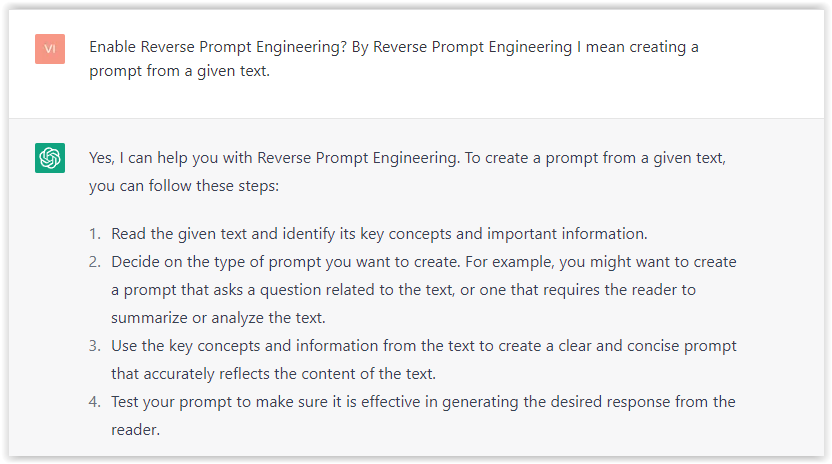 Screenshot from ChatGPT, March 2023
Screenshot from ChatGPT, March 2023You can test other GPT assistants available in the GPTs search engine if you want to use Google results.
Master Reverse Prompt Engineering
ChatGPT can be an excellent tool for reverse engineering prompts because it generates natural and engaging responses to any given input.
By analyzing the prompts generated by ChatGPT, it is possible to gain insight into the model’s underlying thought processes and decision-making strategies.
One key benefit of using ChatGPT to reverse engineer prompts is that the model is highly transparent in its decision-making.
This means that the reasoning and logic behind each response can be traced, making it easier to understand how the model arrives at its conclusions.
Once you’ve done this a few times for different types of content, you’ll gain insight into crafting more effective prompts.
Prepare Your ChatGPT For Generating Prompts
First, activate the reverse prompt engineering.
- Type the following prompt: “Enable Reverse Prompt Engineering? By Reverse Prompt Engineering I mean creating a prompt from a given text.”
 Screenshot from ChatGPT, March 2023
Screenshot from ChatGPT, March 2023ChatGPT is now ready to generate your prompt. You can test the product description in a new chatbot session and evaluate the generated prompt.
- Type: “Create a very technical reverse prompt engineering template for a product description about iPhone 11.”
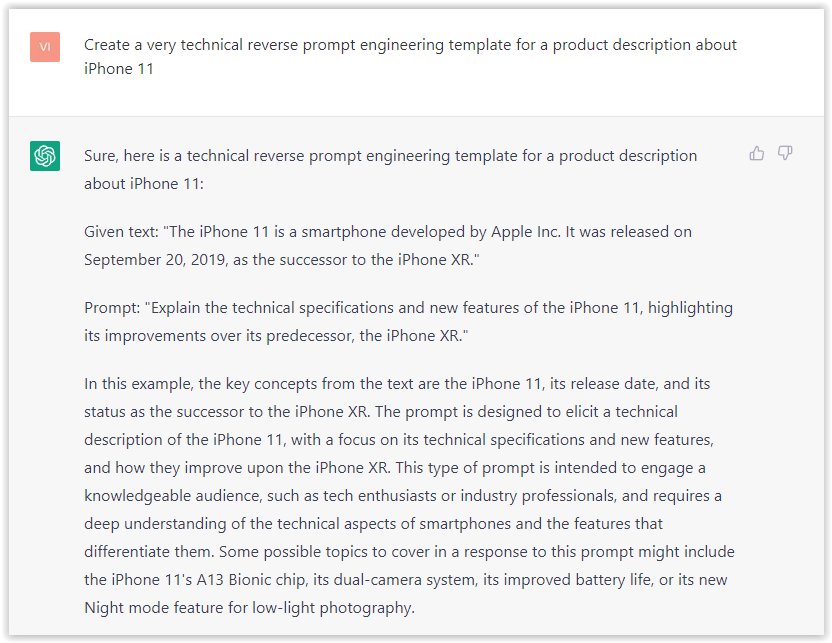 Screenshot from ChatGPT, March 2023
Screenshot from ChatGPT, March 2023The result is amazing. You can test with a full text that you want to reproduce. Here is an example of a prompt for selling a Kindle on Amazon.
- Type: “Reverse Prompt engineer the following {product), capture the writing style and the length of the text :
product =”
 Screenshot from ChatGPT, March 2023
Screenshot from ChatGPT, March 2023I tested it on an SEJ blog post. Enjoy the analysis – it is excellent.
- Type: “Reverse Prompt engineer the following {text}, capture the tone and writing style of the {text} to include in the prompt :
text = all text coming from https://www.searchenginejournal.com/google-bard-training-data/478941/”
 Screenshot from ChatGPT, March 2023
Screenshot from ChatGPT, March 2023But be careful not to use ChatGPT to generate your texts. It is just a personal assistant.
Go Deeper
Prompts and examples for SEO:
- Keyword research and content ideas prompt: “Provide a list of 20 long-tail keyword ideas related to ‘local SEO strategies’ along with brief content topic descriptions for each keyword.”
- Optimizing content for featured snippets prompt: “Write a 40-50 word paragraph optimized for the query ‘what is the featured snippet in Google search’ that could potentially earn the featured snippet.”
- Creating meta descriptions prompt: “Draft a compelling meta description for the following blog post title: ’10 Technical SEO Factors You Can’t Ignore in 2024′.”
Important Considerations:
- Always Fact-Check: While ChatGPT can be a helpful tool, it’s crucial to remember that it may generate inaccurate or fabricated information. Always verify any facts, statistics, or quotes generated by ChatGPT before incorporating them into your content.
- Maintain Control and Creativity: Use ChatGPT as a tool to assist your writing, not replace it. Don’t rely on it to do your thinking or create content from scratch. Your unique perspective and creativity are essential for producing high-quality, engaging content.
- Iteration is Key: Refine and revise the outputs generated by ChatGPT to ensure they align with your voice, style, and intended message.
Additional Prompts for Rewording and SEO:
– Rewrite this sentence to be more concise and impactful.
– Suggest alternative phrasing for this section to improve clarity.
– Identify opportunities to incorporate relevant internal and external links.
– Analyze the keyword density and suggest improvements for better SEO.
Remember, while ChatGPT can be a valuable tool, it’s essential to use it responsibly and maintain control over your content creation process.
Experiment And Refine Your Prompting Techniques
Writing effective prompts for ChatGPT is an essential skill for any SEO professional who wants to harness the power of AI-generated content.
Hopefully, the insights and examples shared in this article can inspire you and help guide you to crafting stronger prompts that yield high-quality content.
Remember to experiment with layering prompts, iterating on the output, and continually refining your prompting techniques.
This will help you stay ahead of the curve in the ever-changing world of SEO.
More resources:
Featured Image: Tapati Rinchumrus/Shutterstock
SEO
Measuring Content Impact Across The Customer Journey

Understanding the impact of your content at every touchpoint of the customer journey is essential – but that’s easier said than done. From attracting potential leads to nurturing them into loyal customers, there are many touchpoints to look into.
So how do you identify and take advantage of these opportunities for growth?
Watch this on-demand webinar and learn a comprehensive approach for measuring the value of your content initiatives, so you can optimize resource allocation for maximum impact.
You’ll learn:
- Fresh methods for measuring your content’s impact.
- Fascinating insights using first-touch attribution, and how it differs from the usual last-touch perspective.
- Ways to persuade decision-makers to invest in more content by showcasing its value convincingly.
With Bill Franklin and Oliver Tani of DAC Group, we unravel the nuances of attribution modeling, emphasizing the significance of layering first-touch and last-touch attribution within your measurement strategy.
Check out these insights to help you craft compelling content tailored to each stage, using an approach rooted in first-hand experience to ensure your content resonates.
Whether you’re a seasoned marketer or new to content measurement, this webinar promises valuable insights and actionable tactics to elevate your SEO game and optimize your content initiatives for success.
View the slides below or check out the full webinar for all the details.
SEO
How to Find and Use Competitor Keywords

Competitor keywords are the keywords your rivals rank for in Google’s search results. They may rank organically or pay for Google Ads to rank in the paid results.
Knowing your competitors’ keywords is the easiest form of keyword research. If your competitors rank for or target particular keywords, it might be worth it for you to target them, too.
There is no way to see your competitors’ keywords without a tool like Ahrefs, which has a database of keywords and the sites that rank for them. As far as we know, Ahrefs has the biggest database of these keywords.
How to find all the keywords your competitor ranks for
- Go to Ahrefs’ Site Explorer
- Enter your competitor’s domain
- Go to the Organic keywords report
The report is sorted by traffic to show you the keywords sending your competitor the most visits. For example, Mailchimp gets most of its organic traffic from the keyword “mailchimp.”


Since you’re unlikely to rank for your competitor’s brand, you might want to exclude branded keywords from the report. You can do this by adding a Keyword > Doesn’t contain filter. In this example, we’ll filter out keywords containing “mailchimp” or any potential misspellings:
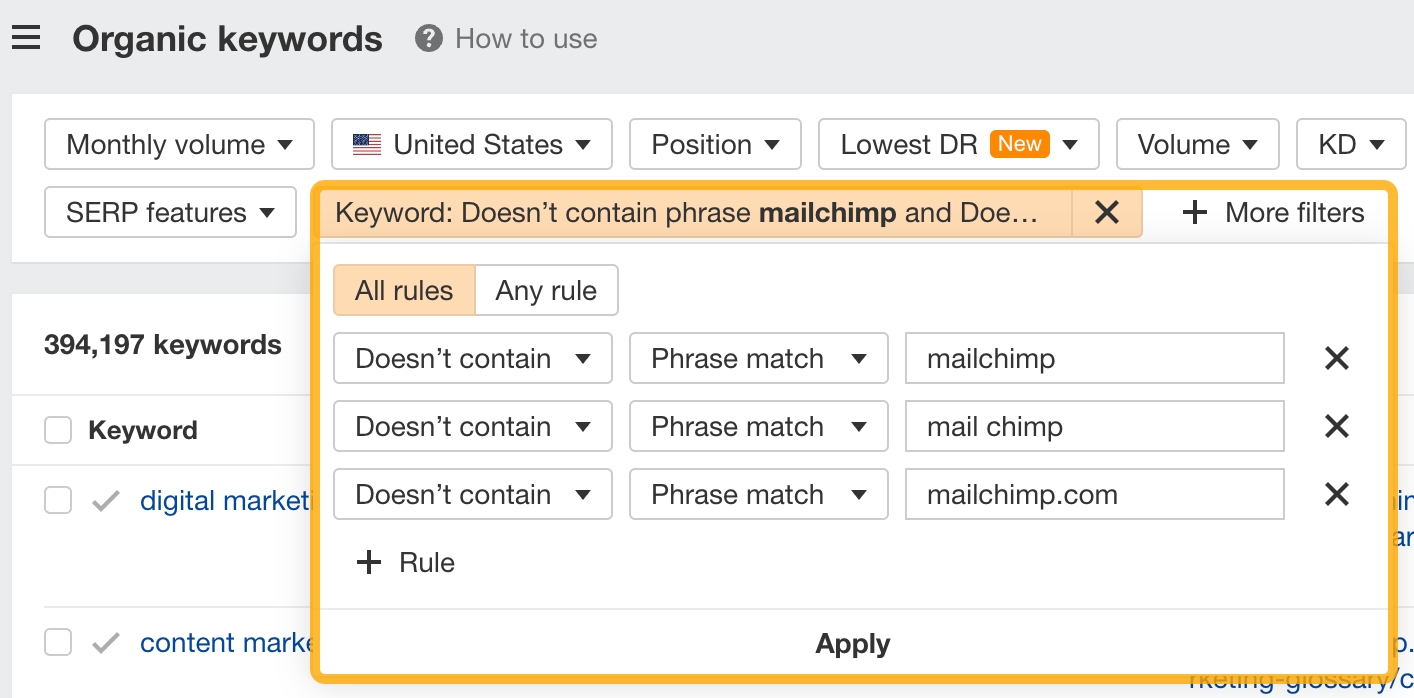

If you’re a new brand competing with one that’s established, you might also want to look for popular low-difficulty keywords. You can do this by setting the Volume filter to a minimum of 500 and the KD filter to a maximum of 10.
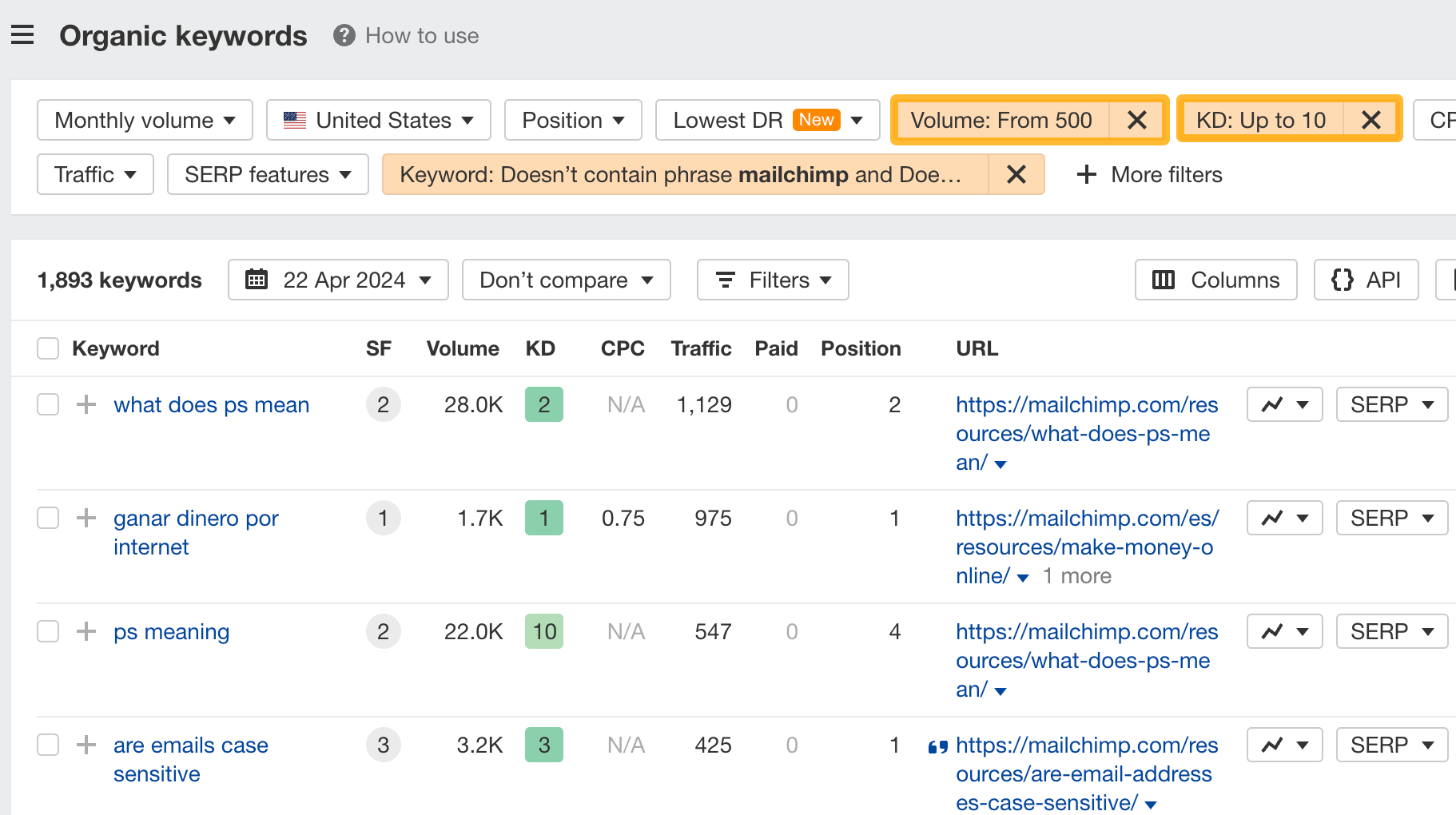

How to find keywords your competitor ranks for, but you don’t
- Go to Competitive Analysis
- Enter your domain in the This target doesn’t rank for section
- Enter your competitor’s domain in the But these competitors do section
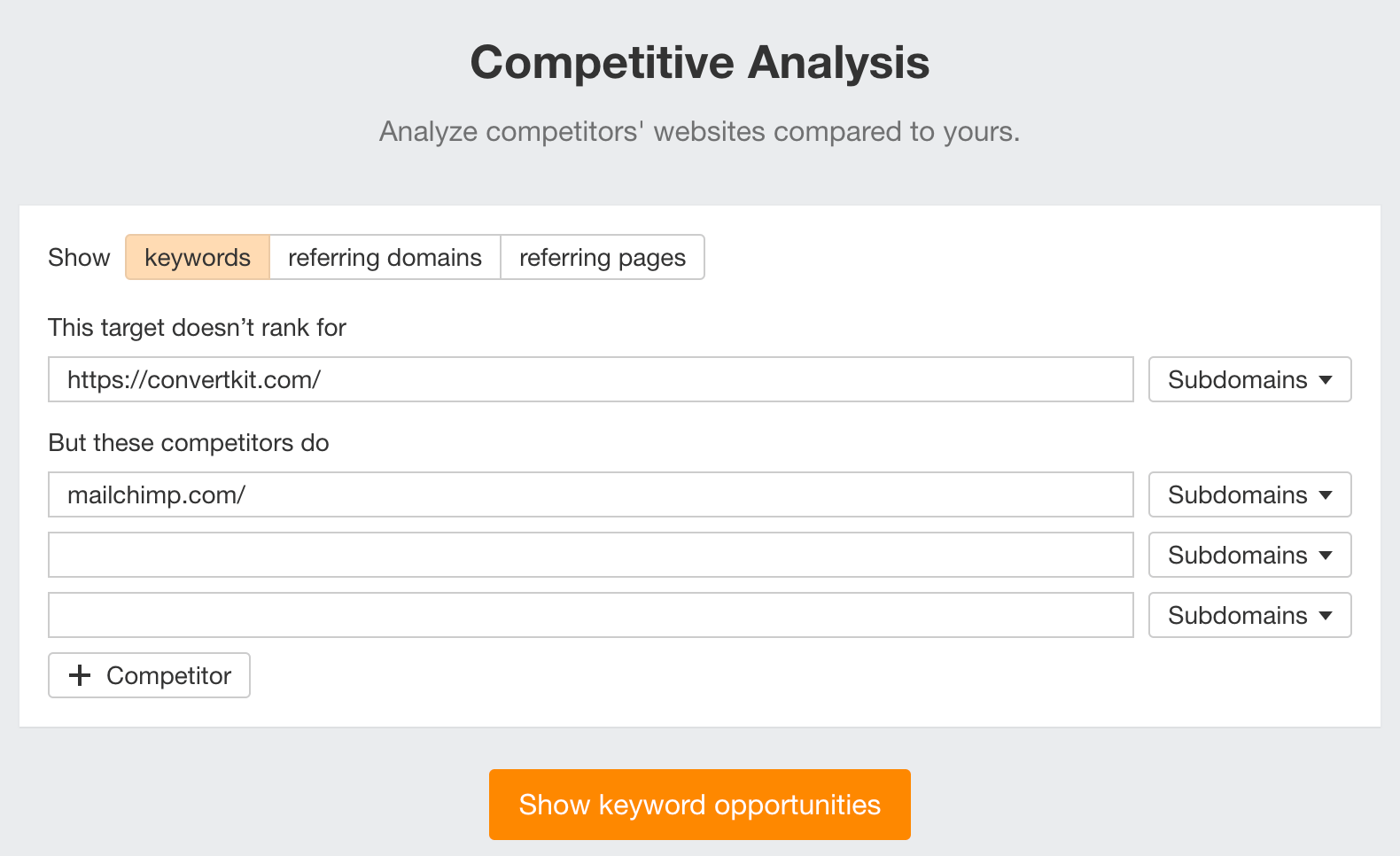

Hit “Show keyword opportunities,” and you’ll see all the keywords your competitor ranks for, but you don’t.
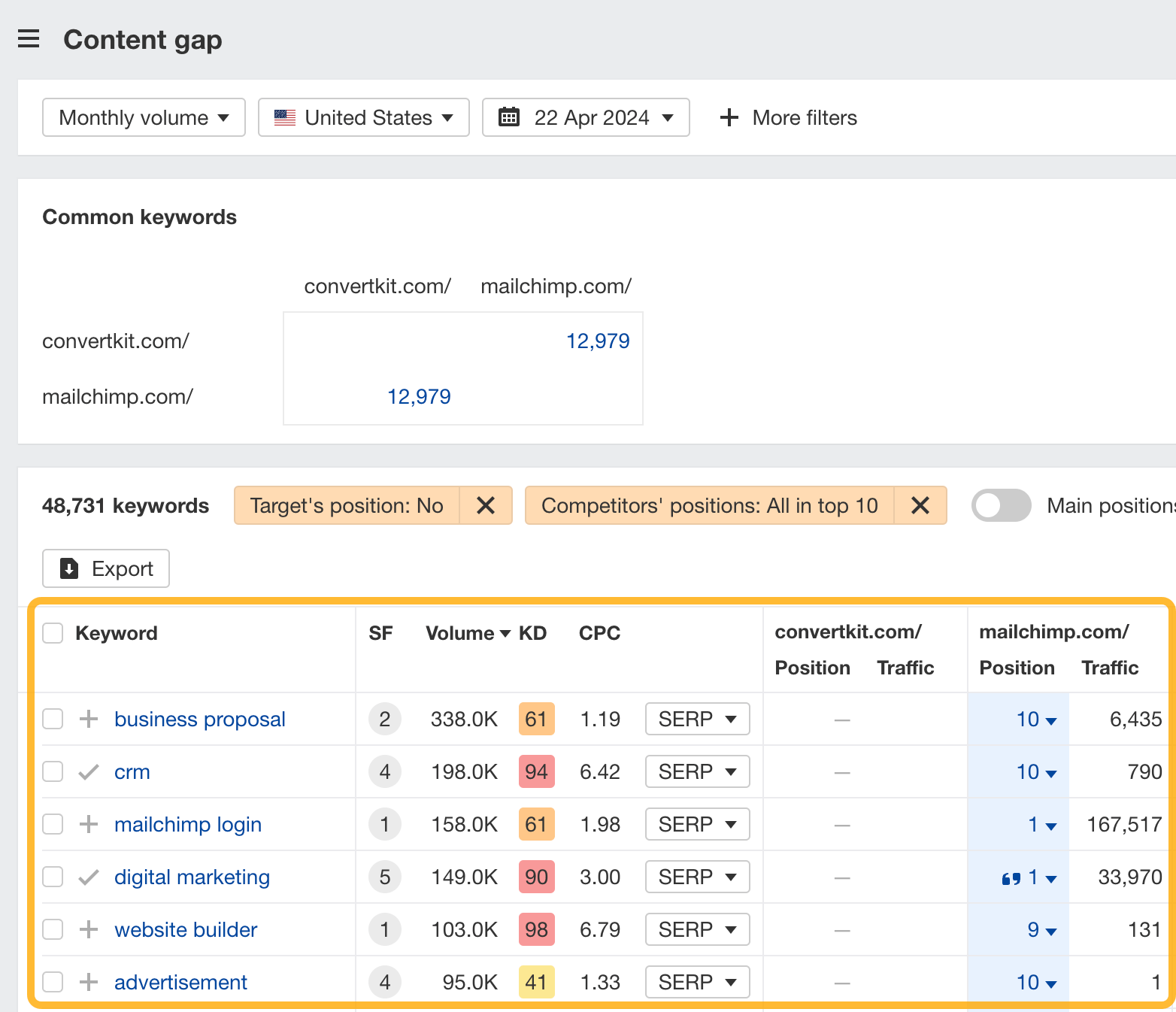

You can also add a Volume and KD filter to find popular, low-difficulty keywords in this report.
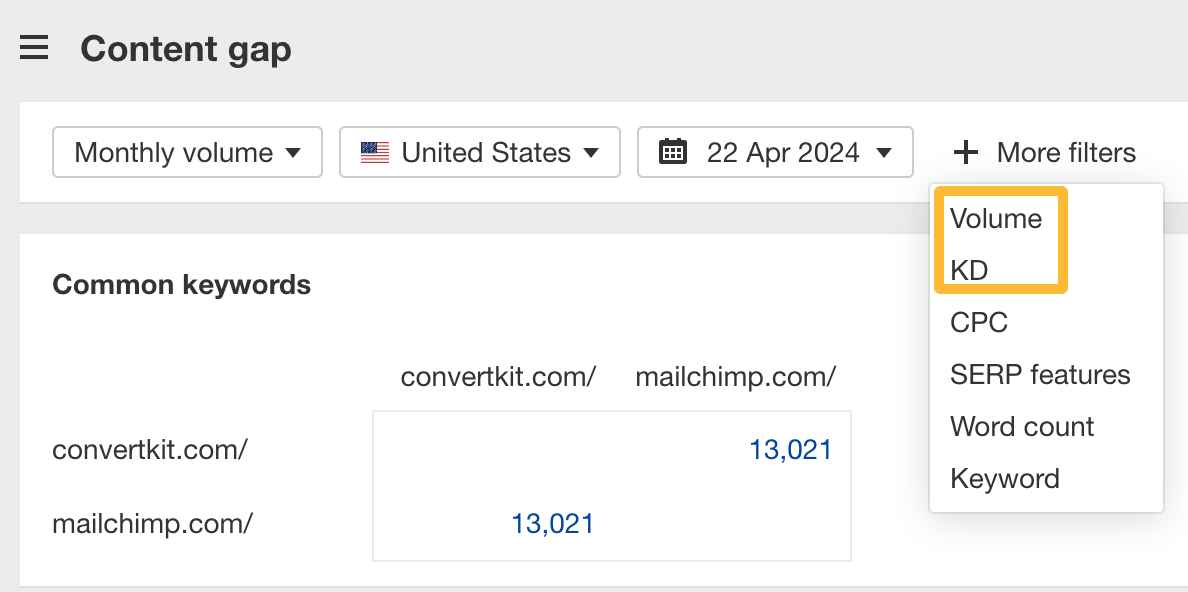

How to find keywords multiple competitors rank for, but you don’t
- Go to Competitive Analysis
- Enter your domain in the This target doesn’t rank for section
- Enter the domains of multiple competitors in the But these competitors do section
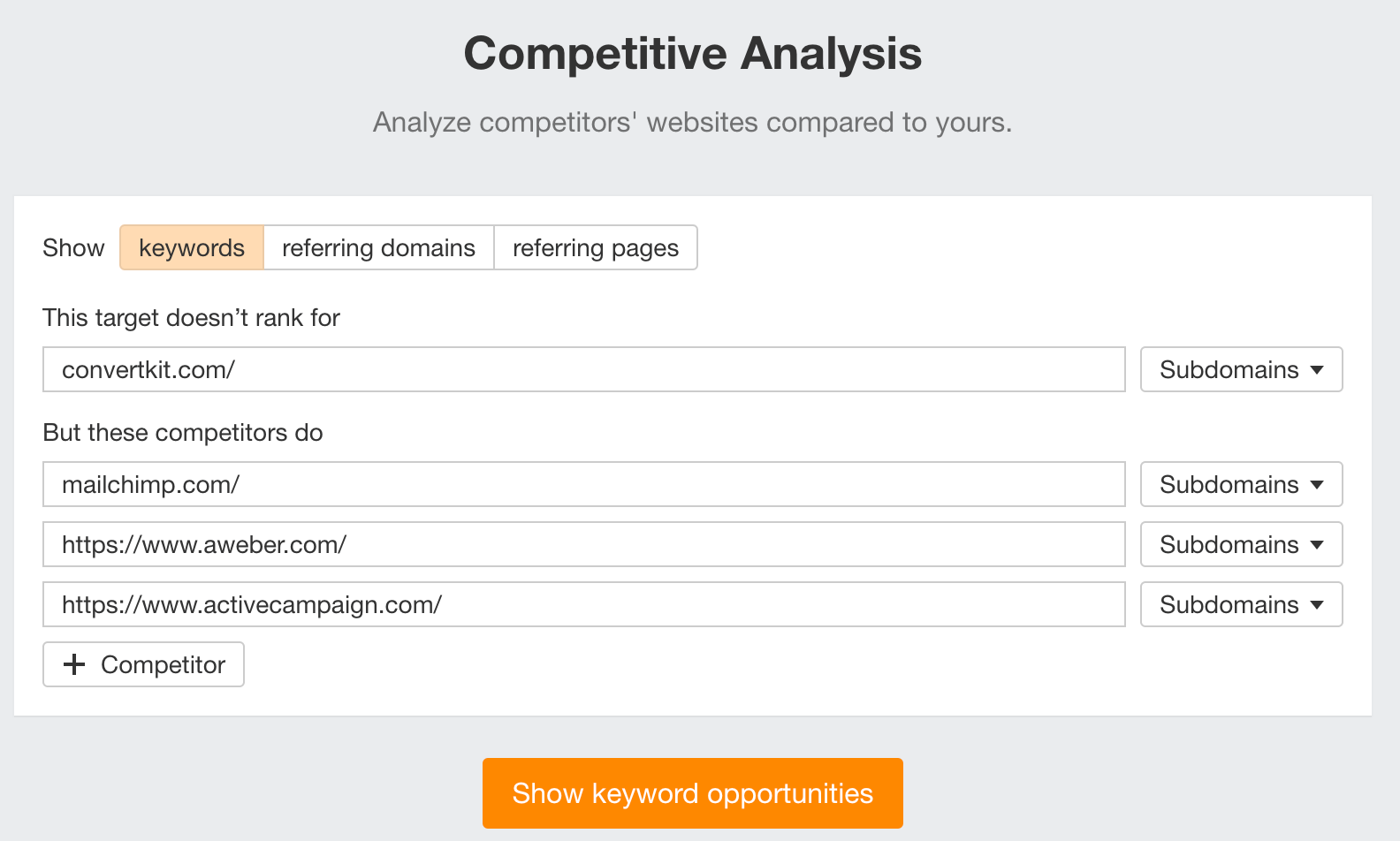

You’ll see all the keywords that at least one of these competitors ranks for, but you don’t.
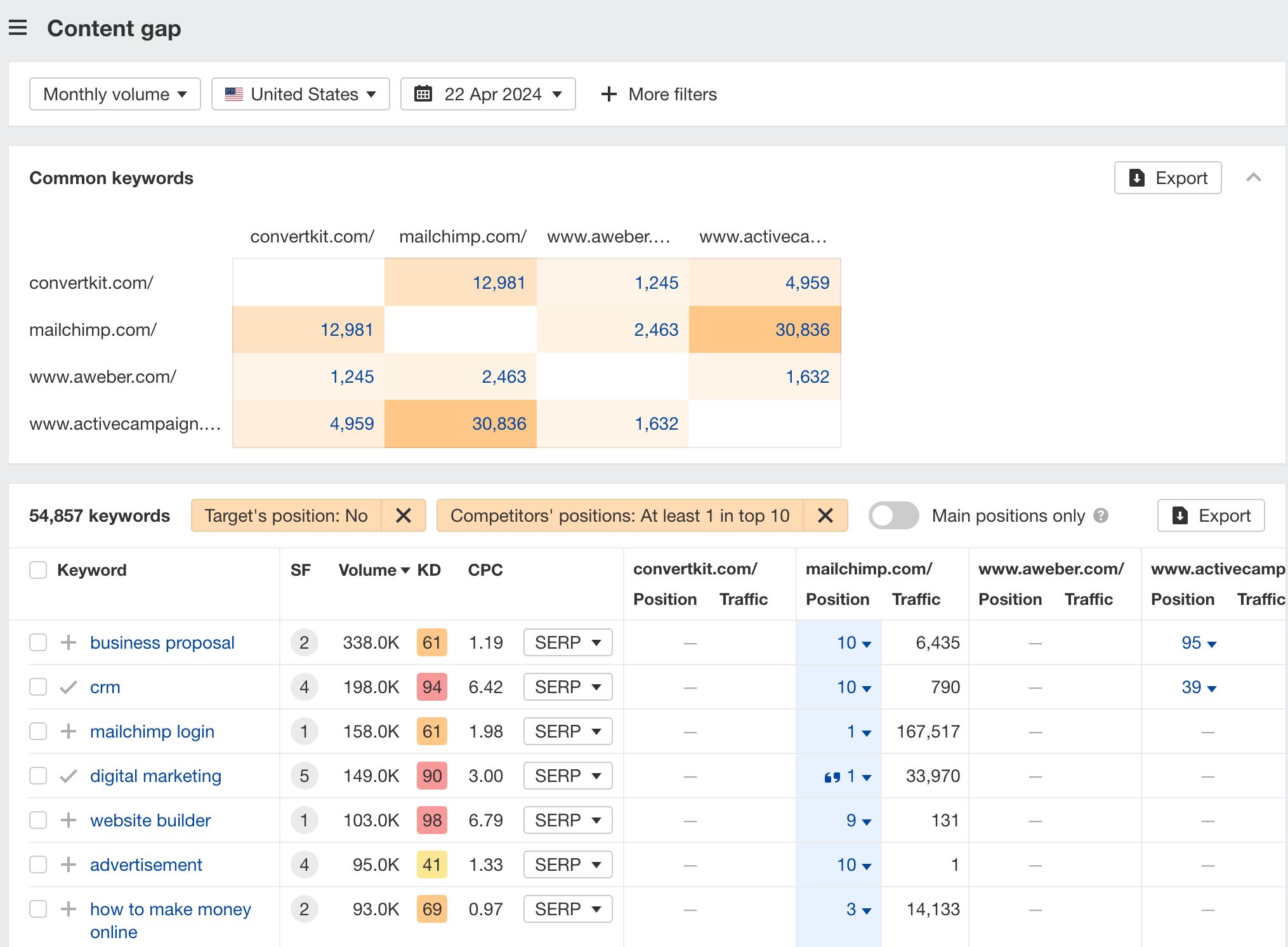

You can also narrow the list down to keywords that all competitors rank for. Click on the Competitors’ positions filter and choose All 3 competitors:
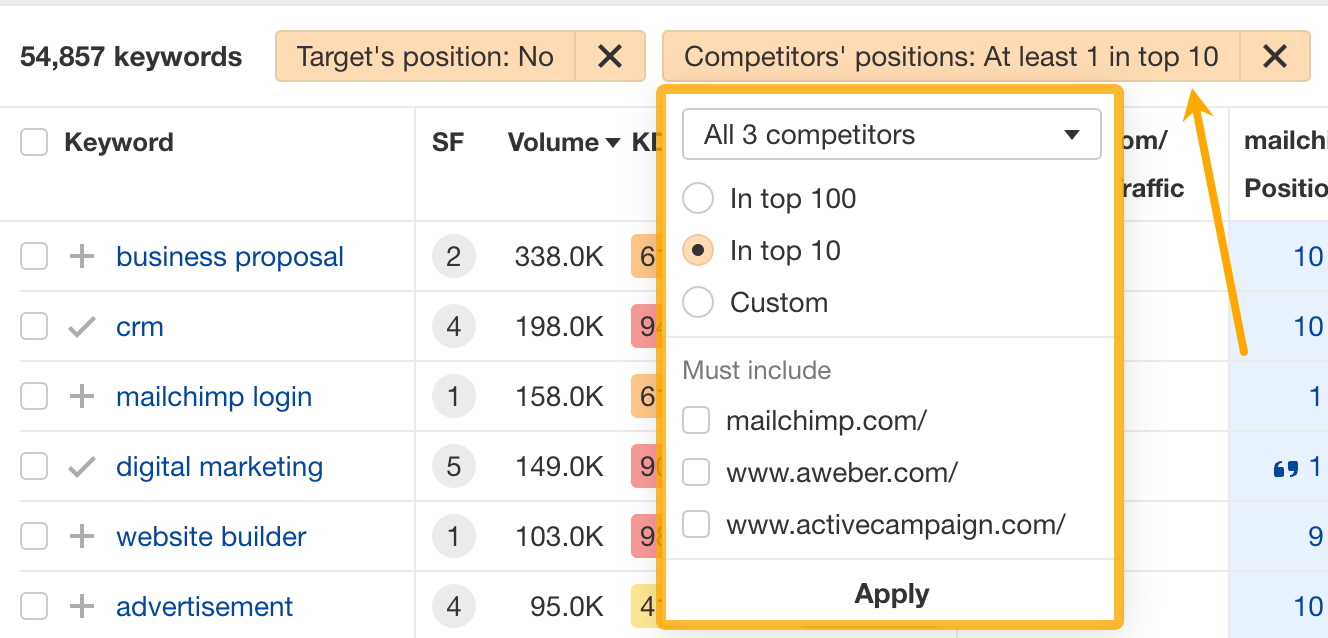

- Go to Ahrefs’ Site Explorer
- Enter your competitor’s domain
- Go to the Paid keywords report
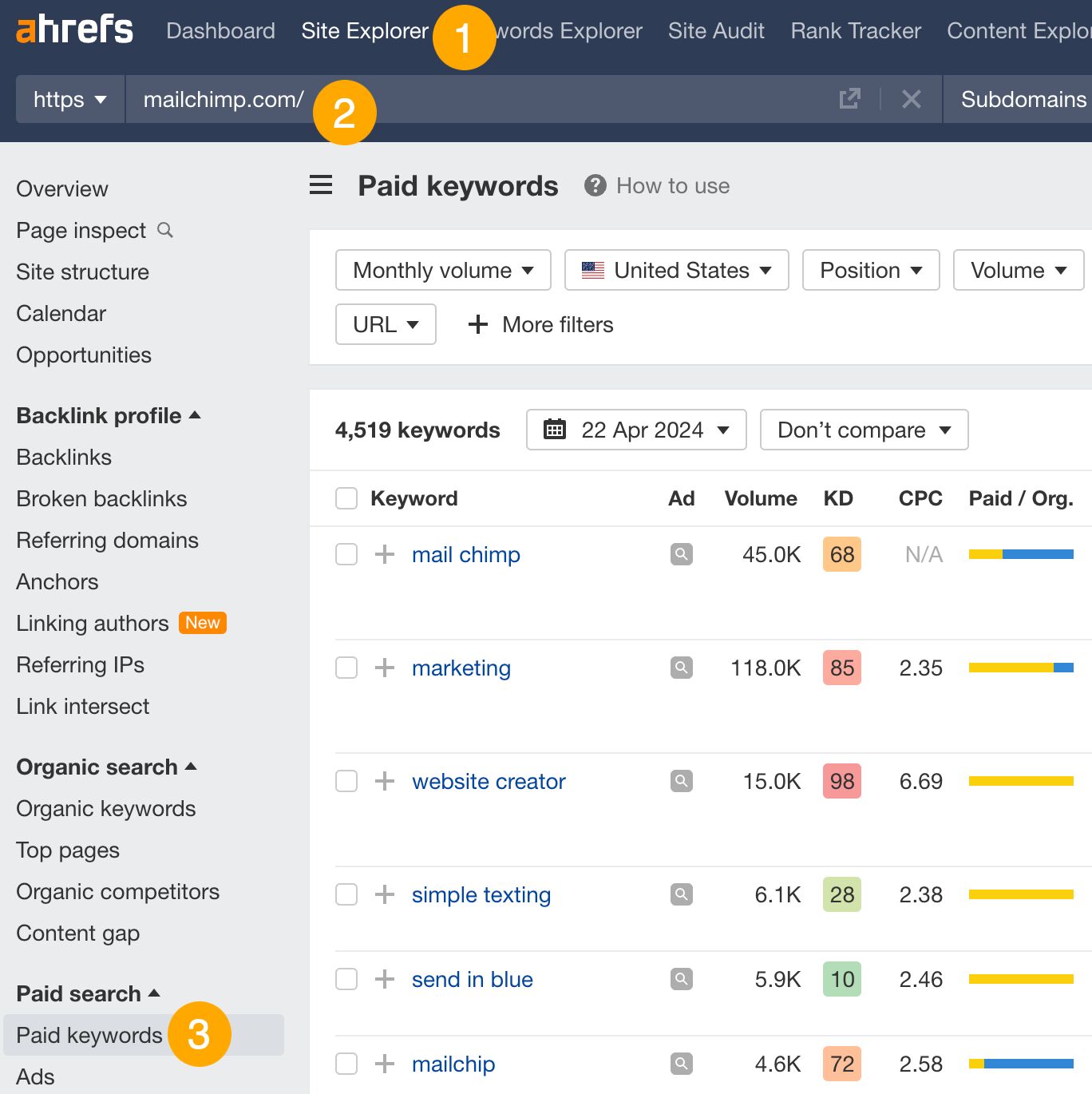

This report shows you the keywords your competitors are targeting via Google Ads.
Since your competitor is paying for traffic from these keywords, it may indicate that they’re profitable for them—and could be for you, too.
You know what keywords your competitors are ranking for or bidding on. But what do you do with them? There are basically three options.
1. Create pages to target these keywords
You can only rank for keywords if you have content about them. So, the most straightforward thing you can do for competitors’ keywords you want to rank for is to create pages to target them.
However, before you do this, it’s worth clustering your competitor’s keywords by Parent Topic. This will group keywords that mean the same or similar things so you can target them all with one page.
Here’s how to do that:
- Export your competitor’s keywords, either from the Organic Keywords or Content Gap report
- Paste them into Keywords Explorer
- Click the “Clusters by Parent Topic” tab
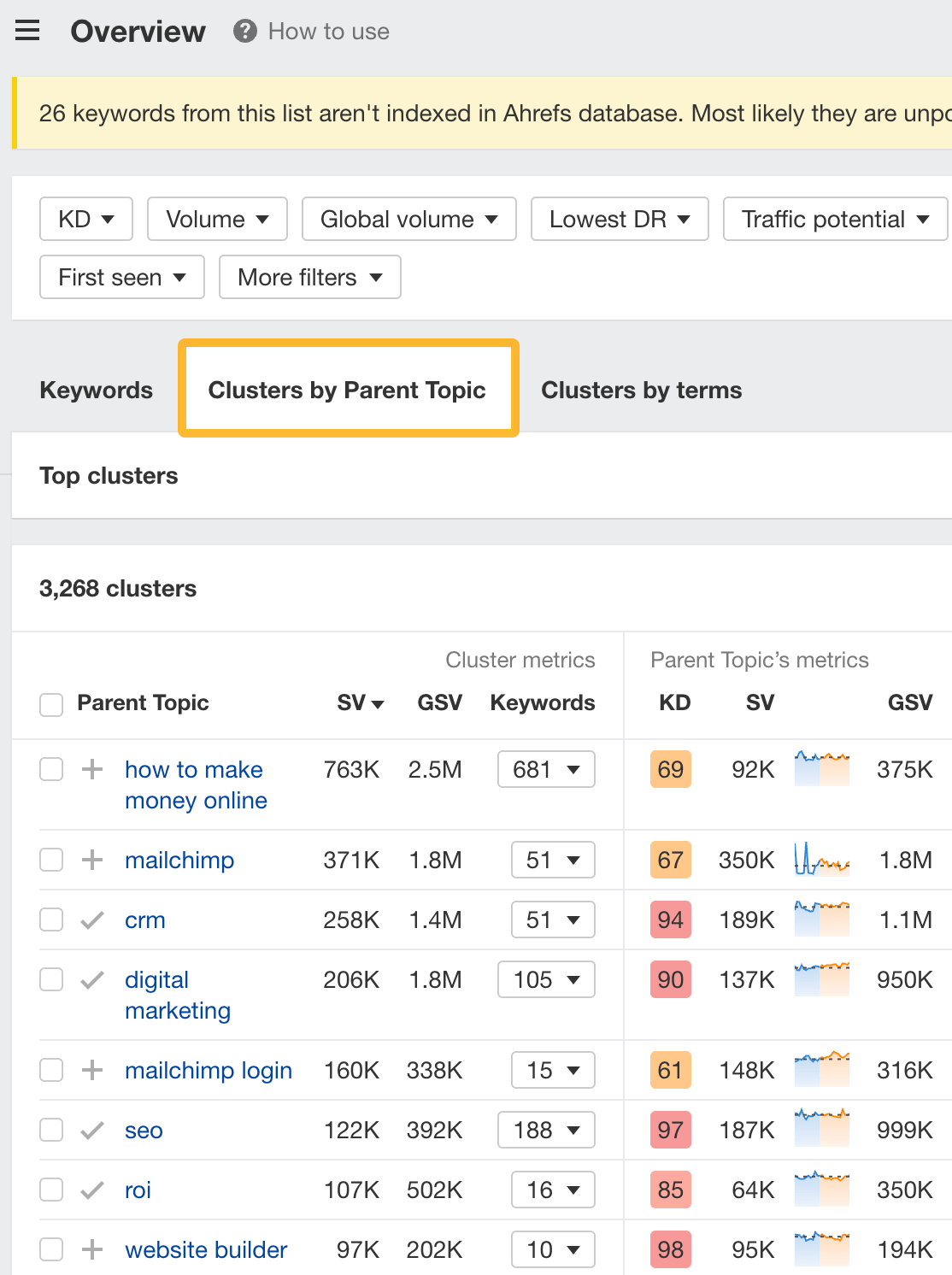

For example, MailChimp ranks for keywords like “what is digital marketing” and “digital marketing definition.” These and many others get clustered under the Parent Topic of “digital marketing” because people searching for them are all looking for the same thing: a definition of digital marketing. You only need to create one page to potentially rank for all these keywords.
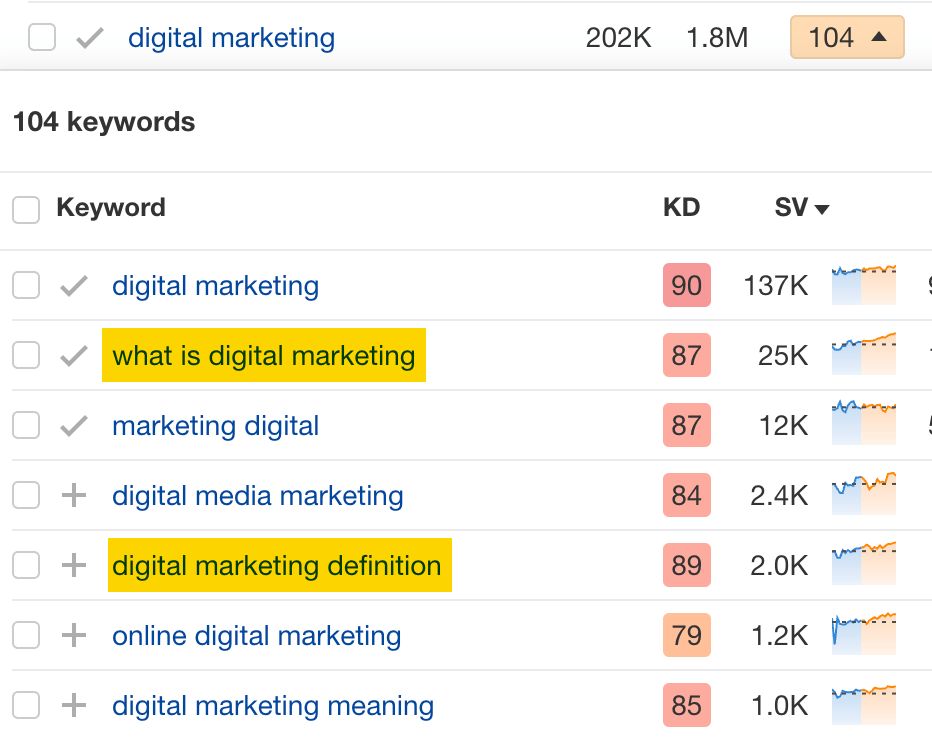

2. Optimize existing content by filling subtopics
You don’t always need to create new content to rank for competitors’ keywords. Sometimes, you can optimize the content you already have to rank for them.
How do you know which keywords you can do this for? Try this:
- Export your competitor’s keywords
- Paste them into Keywords Explorer
- Click the “Clusters by Parent Topic” tab
- Look for Parent Topics you already have content about
For example, if we analyze our competitor, we can see that seven keywords they rank for fall under the Parent Topic of “press release template.”


If we search our site, we see that we already have a page about this topic.


If we click the caret and check the keywords in the cluster, we see keywords like “press release example” and “press release format.”
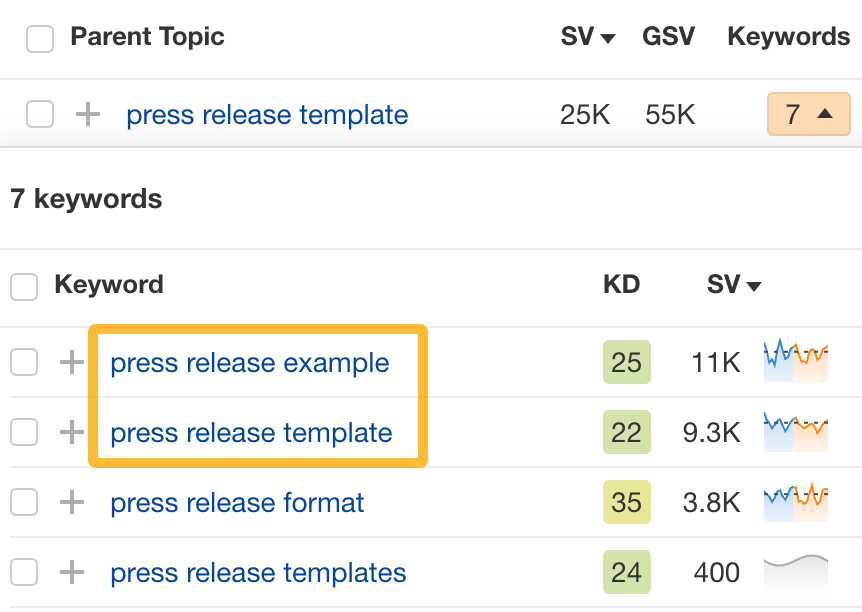

To rank for the keywords in the cluster, we can probably optimize the page we already have by adding sections about the subtopics of “press release examples” and “press release format.”
3. Target these keywords with Google Ads
Paid keywords are the simplest—look through the report and see if there are any relevant keywords you might want to target, too.
For example, Mailchimp is bidding for the keyword “how to create a newsletter.”


If you’re ConvertKit, you may also want to target this keyword since it’s relevant.
If you decide to target the same keyword via Google Ads, you can hover over the magnifying glass to see the ads your competitor is using.
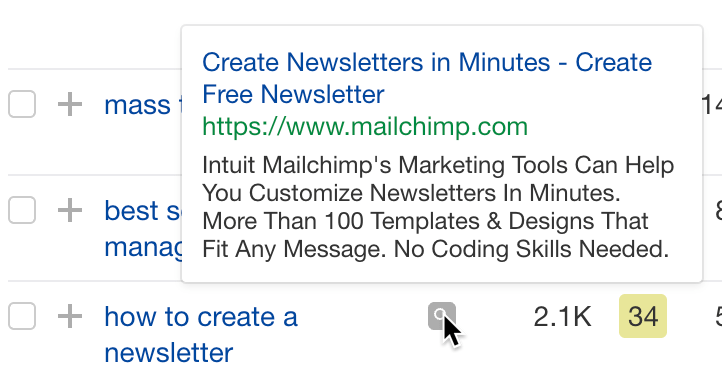

You can also see the landing page your competitor directs ad traffic to under the URL column.


Learn more
Check out more tutorials on how to do competitor keyword analysis:
-

 PPC5 days ago
PPC5 days ago19 Best SEO Tools in 2024 (For Every Use Case)
-

 MARKETING7 days ago
MARKETING7 days agoStreamlining Processes for Increased Efficiency and Results
-
SEARCHENGINES7 days ago
Daily Search Forum Recap: April 17, 2024
-

 PPC7 days ago
PPC7 days ago97 Marvelous May Content Ideas for Blog Posts, Videos, & More
-

 SEO7 days ago
SEO7 days agoAn In-Depth Guide And Best Practices For Mobile SEO
-
SEARCHENGINES6 days ago
Daily Search Forum Recap: April 18, 2024
-

 MARKETING6 days ago
MARKETING6 days agoEcommerce evolution: Blurring the lines between B2B and B2C
-
SEARCHENGINES4 days ago
Daily Search Forum Recap: April 19, 2024
















You must be logged in to post a comment Login